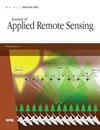通过融合哨兵-2 号多光谱仪和现场高光谱数据估算沿海叶绿素-a 浓度
IF 1.4
4区 地球科学
Q4 ENVIRONMENTAL SCIENCES
引用次数: 0
摘要
通过遥感估算叶绿素 a(Chl-a)浓度是监测近海水质和富营养化的重要手段。现场高光谱数据可以实现对 Chl-a 的精确分析,但不适合区域反演。卫星遥感为区域反演提供了可能,但受限于大气校正结果,精度较低。因此,本研究利用机器学习技术将原位高光谱数据与 "哨兵-2 "号多光谱仪器图像进行融合,结合两者的互补优势,从而提高区域 Chl-a 浓度反演的精度。首先,根据卫星光谱响应函数对原位光谱进行重采样,以获得等效反射率。其次,通过相关分析确定 Chl-a 的光谱特征带。然后,利用支持向量回归、随机森林和反向传播神经网络三种机器学习模型,建立等效反射率与卫星图像反射率之间的特征波段映射关系,从而修正卫星特征波段。最后,根据校正前后的卫星特征波段构建了 Chl-a 反演模型。结果表明,修正后的反演模型的 R2 增加了 0.25,平均相对误差减少了 7.6%。这种融合方法有效地提高了大尺度 Chl-a 浓度估算的精度。本文章由计算机程序翻译,如有差异,请以英文原文为准。
Coastal chlorophyll-a concentration estimation by fusion of Sentinel-2 multispectral instrument and in-situ hyperspectral data
Chlorophyll-a (Chl-a) concentration estimation by remote sensing is an important means for monitoring offshore water quality and eutrophication. In-situ hyperspectral data can achieve accurate analyses of Chl-a, but it is not suitable for regional inversion. Satellite remote sensing provides the possibility for regional inversion, but the precision is lower limited to atmospheric correction result. Therefore, this work uses machine learning to fuse in-situ hyperspectral data and Sentinel-2 multispectral instrument images to combine their complementary advantages, so as to improve the precision of regional Chl-a concentration inversion. First, the in-situ spectra were resampled based on the satellite spectral response function to obtain equivalent reflectance. Second, the spectral feature bands of Chl-a were determined by correlation analysis. Then three machine learning models, support vector regression, random forest, and back propagation neural network, were used to establish mapping relationships of feature bands between equivalent reflectance and satellite image reflectance so as to correct the satellite feature bands. Finally, Chl-a inversion models were constructed based on the satellite feature bands before and after correction. The results demonstrate that the corrected inversion model shows an increase in R2 by 0.25 and a decrease in mean relative error by 7.6%. This fusion method effectively improves the accuracy of large-scale Chl-a concentration estimation.
求助全文
通过发布文献求助,成功后即可免费获取论文全文。
去求助
来源期刊

Journal of Applied Remote Sensing
环境科学-成像科学与照相技术
CiteScore
3.40
自引率
11.80%
发文量
194
审稿时长
3 months
期刊介绍:
The Journal of Applied Remote Sensing is a peer-reviewed journal that optimizes the communication of concepts, information, and progress among the remote sensing community.
 求助内容:
求助内容: 应助结果提醒方式:
应助结果提醒方式:


